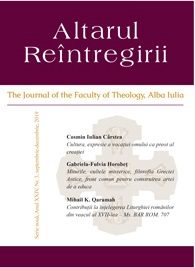Zalmoxis și practicile de dobândire a nemuririi potrivit textului lui Herodot
Zalmoxis and the immortality rituals according to Herodotus Historiae
Author(s): Daniela Luminita IvanoviciSubject(s): Theology and Religion, Comparative Studies of Religion
Published by: Facultatea de Teologie Ortodoxă Alba Iulia
Keywords: Zalmoxis; Herodotus; metempsychosis; Greek mysteries;human sacrifice;
Summary/Abstract: The present study examines the passage from Herodotus Historiae IV, 93-96 where the Greek historian describes the Getaean god, Zalmoxis, and the practices connected with his cult. I will focus my research on two topics: the nature of Zalmoxis and the getic rituals of achieving immortality. Zalmoxis is resented as a man, as a daimon and as a god. In order to clarify this ambiguity, it is imperative to look at the Greek image of “Other”, and a t the projection of Thracians between the civilized Greece and a mythological North. As for the rituals regarding immortality, I`ll start with two rituals described by Herodotus: the sacrifice of a messenger, which was performed every five years, and thedescending of Zalmoxis into an underground chamber. This descent is assimilated with a journey in Hades, a practice connected with Greek mysteries. So, immortality was achieved in two ways: through human sacrifice, or through initiation into the mysteries discovered by Zalmoxis. Herodotus connects this initiation with Pythagora`teachings about metempsychosis. Archaeological discoveries unfold a certain believe in the survival of the soul after death in all Thracia. The findings show that the figure of Zalmoxis is partially constructed on the Greek representation about world. The information about his doctrine of immortality is real, since it exists not only among the Getae tribe, but also among other Thracian tribes.
Journal: Altarul Reîntregirii
- Issue Year: XXIV/2019
- Issue No: 3
- Page Range: 103-113
- Page Count: 11
- Language: Romanian

